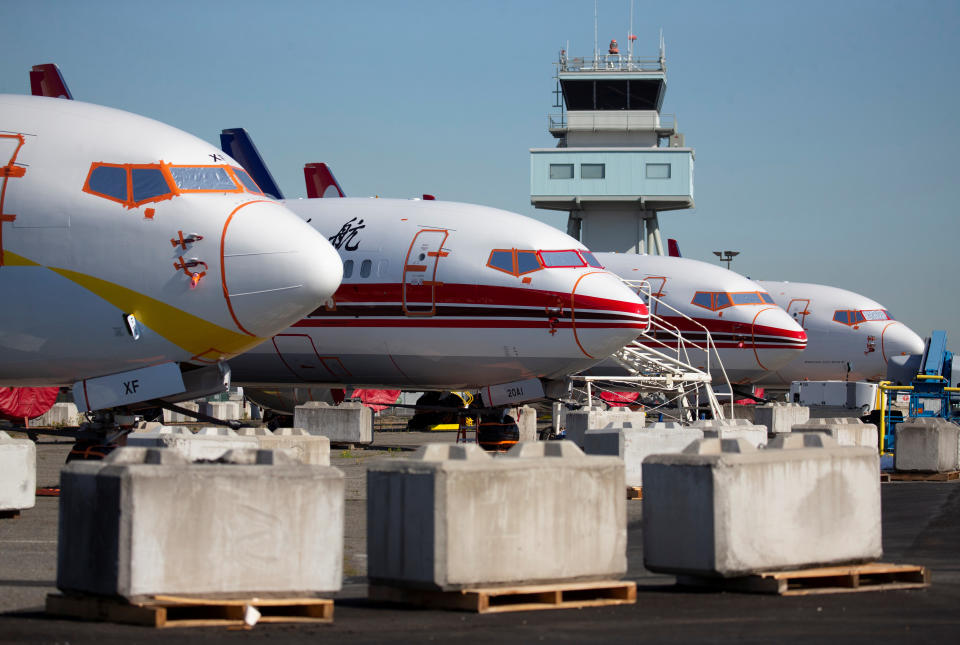Boeing CEO: Preliminary investigations show 737 Max pilots exposed to 'high workload environment'
Pilots who were unable to save two separate commercial Boeing 737 Max airplanes from crashes that killed 346 people were exposed to a “high workload environment,” according to early findings from an investigation, Boeing’s (BA) CEO Dennis Muilenburg said Wednesday during an address to the Economic Club of New York in Manhattan.
Boeing has previously acknowledged that during both flights faulty data from a single external airplane sensor triggered an automatic system known as MCAS that adjusted the angle of the aircraft downward. However, in defense of the plane’s design, Muilenburg has raised pilot inaction as a factor in a chain of events that could determine whether pilots successfully troubleshoot to disengage MCAS (Maneuvering Characteristics Augmentation System) and recover the aircraft.
“If that kind of scenario occurs and you go through the checklist...it calls out actions that would be taken around power management and pitch management of the airplane,” Muilenburg said in response to a reporter during the company’s annual shareholder event in April.
“It also refers to the cutout switches, that after an activation that was not pilot-induced, that you would hit the cutout switches,” he added. “And, in some cases, those procedures were not completely followed.”
‘More workload for pilots’
While much debate has ensued over whether highly trained pilots would have avoided the fatal crashes, Muilenburg’s statements Wednesday acknowledged investigators’ determination that MCAS software compounded pilots’ emergency troubleshooting environment.
“While the investigations have not yet issued their final reports, they have shared preliminary findings,” Muilenburg said. “The early information established that in both lights, a software function activated in response to incorrect information from an external airplane sensor as part of a broader chain of events that created more workload for the pilots in what was already a high workload environment.”

In testimony before Congress in June, Chesley “Sully” Sullenberger, the decorated commercial airline captain responsible for saving the lives of 155 people in a heroic 2009 landing on New York’s Hudson River, emphasized the significance of pilot “startle factor” and chaotic cockpit situations that play into a pilot’s emergency response capabilities.
Asked by Rep. Thomas Massie (R-KY) whether more experienced pilots would have been able to handle the MCAS-related emergencies, Sullenberger opined that it would have been unlikely they would have performed differently from the crews on the accident flights.
“I'm one of a relatively small group of people who have experienced such a crisis and lived to share what we learned about it. I can tell you firsthand that the startle factor is real. And it's huge. It absolutely interferes with one's ability to quickly analyze the crisis and take an active action,” Sullenberger said.
‘Grab the weel, keep it from turning’
Still, former FAA Certification and Regulatory Enforcement Support specialist, Larry Williams, has said any experienced pilot should have been able to handle the Max emergencies.
“You grab the yoke and pull it back and if you can’t override it you just kick off trim and fly it manually. It’s autopilot disconnect, basically. Push a button on the yoke and disconnect — grab the wheel, keep it from turning.”
As a result of the findings, Boeing is altering both how much exterior data the 737 Max intakes, as well as the number of backup systems to recognize when an automatic adjustment of the plane’s nose is in error. After alterations, each Max will be equipped with three redundancies, including two exterior “angle of attack” sensors, instead of one; single automatic activation of the MCAS system, rather than multiple activations; and a pilot override, to stop MCAS from pushing the nose down once a pilot takes control.
Max planes were grounded by the FAA on March 13 following the second of two similar crashes that killed all passengers and crew on board. Shortly after takeoff from Jakarta, Indonesia, on October 29, Lion Air Flight 610 crashed into the Java Sea. Ethiopian Airlines Flight 302 crashed shortly after takeoff from Addis Ababa, Ethiopia, on March 10.
Alexis Keenan is a reporter for Yahoo Finance. She previously worked for CNN and is a former litigation attorney. Follow on Twitter @alexiskweed.
Read the latest financial and business news from Yahoo Finance
Follow Yahoo Finance on Twitter, Facebook, Instagram, Flipboard, SmartNews, LinkedIn, YouTube, and reddit.

